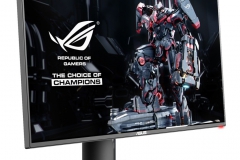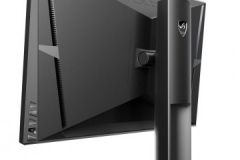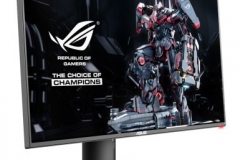Landing on my desk a few weeks ago was an ASUS ROG Swift PG278Q monitor for me to put through its paces. It’s been out a little while now, and I’ve been weighing up a monitor upgrade for some time, so I was keen to see what this multi award winner could do. Could I justify it as a personal upgrade, given its hefty price tag of around 1000 Australian (as weak as they are) dollars?

With 4k becoming more and more prevalent, would I be better off waiting? The voice of reason in the back of my head says “don’t be silly James, what graphics card is capable of doing 4k in anger? Remember when you were thinking about buying a 4k TV 18 months ago?” Well that would have been pretty dumb because there still ain’t much 4k content around and that doesn’t look like changing in a hurry. Perhaps it’s the same with monitors. You can stall and procrastinate all you like, but realistically, it’s probably a couple of years before we have hardware capable of generating 4k gaming content on the fly at the sort of hyper frame rates we are used to with HD.
To assist with testing, ASUS kindly provided us with a Poseidon GTX980 with 4GB of VRAM, capable of pushing out the 1440p at 144khz this monitor demands. I swapped out my aging GTX 670 and was ready to test!
Unboxing was a piece of cake, as was assembly….’cos I didn’t have to do it! That’s right, the PG278Q comes pre-assembled to its stand which is great. Another tick for tech that allows you to swivel a monitor and make it portrait: it also seems to lend itself to packaging better.
The monitor comes with a Display port cable, not HDMI, so you may want to take note of that. A word of caution with the DisplayPort cable – perhaps it’s the case with all of these but this is the first time I noticed it – the little prongs on the end of the gold plug that are used to “lock” the connector into place are quite sharp. Watch your fingers, they could easily give you a little nick. Once the cable is connected snugly between your devices there is no way it’s going anywhere. It has a premium feel.
Key Feature
- ASUS GamePlus – Displays a crosshair overlay and timer-count down for respawn
- 5-way menu control joystick – On the right-hand side of the monitor, a tiny joystick with 5-way movement is used to control the OSD. This makes any monitor adjustments extremely easy and quick.
- Displayport – NVIDIA’s G-Sync input currently requires DisplayPort in order to function, so this is the only input available.
- The PG278Q ROG SWIFT monitor comes bundled with a high-quality DisplayPort cable.
- The PG278Q ROG SWIFT monitor fully supports VESA wall mount capability
- The SWIFT is truly flexible offering full tilt, swivel, pivot and height adjustment allowing full portrait mode if required.
- Thin bezel – The SWIFT features a 6mm ultra narrow bezel. Making it an excellent choice for users considering multi monitor setups.
Specifications
|
PG278Q ROG SWIFT |
|
|
Display |
|
|
Product Colour |
Black-Red |
|
True Resolution |
2560×1440 * |
|
Pixel Pitch |
0.233mm |
|
Brightness(Max) |
350 cd/㎡ |
|
Contrast Ratio (Max) |
1000:1 |
|
Viewing Angle (CR≧10) |
170°(H)/160°(V) |
|
Response Time |
1ms (Gray to Gray) |
|
Display Colors |
16.7M (real 8 bit) |
|
Video Feature |
|
|
Trace Free Technology |
Yes |
|
Color Temperature Selection |
4 Modes |
|
3D Technology |
3D Technology |
|
GamePlus(modes) |
Yes (Crosshair/Timer) |
|
HDCP support |
Yes |
|
Convenient Hotkey |
|
|
GamePlus |
|
|
I/O Ports |
|
|
Signal Input |
DisplayPort 1.2 |
|
USB Port(s) |
3.0×2 |
|
Signal Frequency |
|
|
Digital Signal Frequency : 89~222KHz(H)/50~144Hz(V) |
|
|
Power Consumption |
|
|
Power On: <38.7W** |
|
|
Mechanical Design |
|
|
Chassis Colors : Black |
|
|
Security |
|
|
Kensington lock |
|
|
Weight |
|
|
Net Weight (Esti.): 7.0Kg |
|
|
Accessories |
|
|
Power cord |
|
|
Regulation Approval |
|
|
Energy Star®, BSMI, CB, CCC, CE, CEL level 1, C-Tick, CU, ErP, FCC, J-MOSS, KCC, PSE, RoHS, UL/cUL, VCCI, WEEE, WHQL (Windows 8, Windows 7), TUV Flicker-free |
|
|
Note |
|
|
Powered by NVIDIA G-SYNC Technology and NVIDIA Ultra Low Motion Blur Technology. *WQHD Resolution **Based on EnergyStar 6.0 testing standard |
|
Build quality and performance

In my excitement, I didn’t insert the CD that came with the monitor, hoping Windows 10 would have the good sense to detect the monitor – instead it detected it as a generic 59khz device – no biggie. I downloaded the INF file from ASUS and pointed Windows at it – mapping complete.
Starting the monitor up I was pleased to see it has a nice matte finish which doesn’t pick up light from other sources. Viewing angles are superb and despite being a TN monitor, are not unlike an IPS panel. Text is crisp. Colours are vivid and not over saturated. Colour balance looked spot on to my eye, not too cool, not too warm. Screen uniformity was excellent.
If you are not used to 27 inch monitors – prepare yourself to see a lot of screen not used well – i.e. blank….the fault of website designers and app designers (i.e. the Facebook windows 10 app) more than anything. For general website browsing you might find the whole experience not that revolutionary – i.e. not like when you first made that jump from 15 inch CRT to 21inch 16:9 LCD – however, some things such as the Windows 10 email client looked just glorious on 27 inch @ 2560 x 1440. From a productivity perspective there’s no doubt there are huge benefits to a monitor of this size.

But anyhow, you probably aren’t interested in this monitor for its ability to balance the accounts or do your tax on, you wanna use it to tear through some games and immerse yourself in the technology doing it. So how does it stack up?
Well it’s fantastic! The response is flawless, and on the games we tested it on – TESO, Metro Last Light, Satellite Reign to name a few. An NVIDIA card with a G-sync capable monitor is a match made in heaven; we didn’t see any screen tearing even with the Poseiden GTX980 pumping out a blistering 90 frames in TESO.


The build quality is top notch, the stand is very supportive, and there is no wobble. This is due to the large footprint of the base. The tilting mechanism is very generous and allows you to switch to Portrait / reading mode very easily.
The red “ring” around on the base looks pretty cool but some might not like it as it is quite bright and could be distracting, however it can be turned off if desired. The ring colour actually does mean something, and it changes depending on the mode the monitor is in.
Colours/ modes are:
- White – normal ‘fast’ gaming (up to 144Hz)
- Green –Nvidia Stereoscopic 3D hardware plugged into the PC and 3D Vision enabled
- Red – G-Sync enabled
- Yellow – Ultra Low Motion Blur
- Orange – Standby
|
The monitor has 5 buttons which serve different functions:
|
 |
The ROG Swift PG278Q also features two USB 3.0 ports, powered by the monitor’s internal power. When you turn on the monitor or it is in standby, you can use it to charge your smartphone/tablet (up to 1.2A).
The Gameplus feature is interesting. It allows you to set your own crosshair up. This is a huge advantage in games like Call of Duty which don’t have a crosshair! You simply select the type of crosshair you want and the position and you’re away. The Timer can be used to assist with respawn timing.

G-sync / Freesync – what’s all that about?
NVIDIA G-Sync technology synchronizes the monitor’s refresh to the GPU’s render rate to provide stunning smoothness and ultra-fast response NVIDIA’s mortal enemy, AMD, uses a technology known as Freesync which is essentially the same thing but pairs AMD hardware with Freesync enabled monitors.
Basically you want to try and pair your monitor to your graphics card.
As far as the ASUS monitor lineup goes, the PG278Q leverages Nvidia’s G-Sync for on-GPU frame syncing technology, whereas the MG279Q uses AMD’s FreeSync.
ASUS recommend you use the monitor best aligned to your card. This made me wonder, what’s an NVIDIA user who is after an IPS panel meant to do? Forgo the whole on GPU syncing tech? Well the answer comes from ASUS themselves – later this year they propose releasing the ASUS PG279Q an IPS with G-sync support!
So you may want to consider hanging out until then if this is the combination you want.
Tech talk – To TN or to IPS?
TN panel technology has been around for ages, and has been refined to a point where, it’s no longer uncool to have one. The main benefit of a TN panel is the refresh rates they are able to produce exceed what can be typically done with IPS. IPS is considered to have better colour reproduction and viewer angles, and historically have been the domain of the graphics designers and professionals – however this has changed in recent years as they have gone from being hideously expensive to accessible by average punters like you and me.
ASUS have picked up on the strengths of both technologies and have provided the ROG Swift PG278Q with its 1ms 144khz responsiveness in a TN package.
For those wanting a 27inch ASUS screen utilising IPS, look to the MG279Q. It can do 144khz however it comes with a slower 4ms response.
Republic Of Gamers
The monitor is ROG branded –aka “Republic of Gamers”. ROG is a brand formed by ASUS in 2006 for gaming enthusiasts – which sponsors a number of gaming events and looks to push the envelope that little bit further in terms of hardware and performance. In that time they have a huge online presence.
The ROG Twitter account is @ASUS_ROG and has a massive 232k followers, check it out https://twitter.com/ASUS_ROG
Check the website out here which gives a good history of ROG and their impact on the games industry.
http://rog.asus.com/about-rog/
Conclusion
I can honestly say this is the best monitor I’ve ever used. I felt like a family pet had died when I had to give it back.
If performance is paramount for you, and you are wielding an NVIDIA GPU, then this is your monitor. I’m sure it works fine with an AMD GPU too, but you are probably better looking at the MG279Q as mentioned, in that case.
This is a TN monitor, and I am keen to see what the IPS with G-sync capable PG279Q can deliver when it comes out in the near future. It could well be better, hard to imagine but possible!
| ASUS ROG Swift PG278Q Monitor | |
 |
|
|
PROS |
|
|
CONS |
|
| Awards |  |













